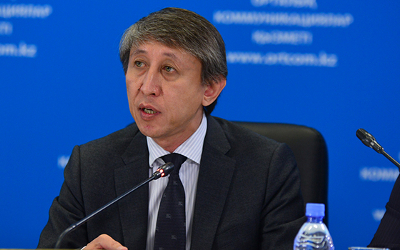Kazakhstan expects oil output at 92 mln tons in 2020

By Aynur Karimova
Central Asian energy-rich state Kazakhstan expects oil production at 92 million tons in 2020.
This remark was made by the country's Deputy National Economy Minister Marat Kusainov during the presentation of the draft state budget for 2016-2018 in the Majilis of Parliament on September 15, local media reported.
“The oil production forecast by the Ministry of Energy in 2016 will amount to 77 million tons, followed by an increase to 92 million tons in 2020, which is lower than the previously forecasted data by about 3.8 million tons and 12 million tons respectively,” he said.
Kazakhstan's three-year budget project is based on the forecast of socio-economic development for 2016-2020 approved by the country's Cabinet of Ministers in August 2015.
“It is expected that the volume of industry in 2016 will remain at the level of the current year, followed by growth from 1.7 percent in 2017 to 3.8 percent in 2020,” the official noted.
Kusainov went on to add that the average annual growth of gross agricultural output in 2016-2020 will amount to 2.8 percent per year, the growth rate of trade in services will amount to 4.5 percent, while the volume of transport services, information, and communications is expected to remain at the same level as in 2015.
"During the formation of the forecast for the macroeconomic index and budget parameters, the estimated rate of tenge was taken at the level of 250 tenge to one dollar,” Kusainov said.
Kazakhstan produces oil mainly from its largest Karachaganak and
Tengiz fields.
The Karachaganak field is one of the world's largest fields. Its
oil reserves amount to 1.2 billion tons while natural gas reserves
are estimated at 1.35 trillion cubic meters.
About 49 percent of Kazakhstan's gas production and 18 percent
of oil production are extracted from this field.
The Tengiz field in the west of the country is one of the deepest
and largest oil fields in the world. Total estimated reserves
amount to three billion tons (26 billion barrels).
Another large oil and gas field, Kashagan, is located in the north
of the Caspian Sea. Oil production at Kashagan started in September
2013, but operation was suspended when a gas leak appeared from the
ground pipeline.
Kazakhstan's budget deficit to decrease from 2016 to 2018
The government expects Kazakhstan's state budget deficit at 723.4 billion tenges ($2.55 billion) in 2016, 600.8 billion tenges ($2.12 billion) in 2017, and 552.3 billion tenges ($1.95 billion) in 2018.
Given the projected GDP growth and import volumes, state revenues added to the state budget (excluding transfers) are projected at 3.513 trillion tenges ($12.4 billion) in 2016, 3.724 trillion tenges ($13.2 billion) in 2017, and 4.132 trillion tenges ($14.59 billion) in 2018.
Kazakh budget expenditures are projected at 7.319 trillion tenges ($25.84 billion) in 2016, 7.731 trillion tenges ($27.3 billion) in 2017, and 7.457 trillion tenges ($26.33 billion) in 2018.
Total revenues of the republican budget in 2016 will amount to 6.595 trillion tenges ($23.28 billion), 7.13 trillion tenges ($25.17 billion) in 2017 and 6.905 ($24.38 billion) trillion tenges in 2018.
Kazakhstan to see growth in GDP
The Kazakh government expects a 2.1 percent GDP growth in 2016. This was envisaged in the socio-economic development of Kazakhstan for 2016-2020, approved by the government.
In accordance with forecasts, real GDP growth in Kazakhstan is expected to reach 3.6 percent in 2017, 2.9 percent in 2018, 3 percent in 2019, and 3.1 percent in 2020.
In 2014, real GDP growth in Kazakhstan amounted to 4.3 percent, while in the first half of 2015, the GDP growth in Kazakhstan stood at 1.7 percent.
The nominal GDP growth for 2016-2020 is projected at 7.4-9.8 percent.
In accordance with forecasts, GDP per capita in Kazakhstan will amount to more than $10,000 in 2016 and increase to $13,200 in 2020.
Exports will increase from $41 billion in 2016 to $55.1 billion in 2020, and imports from $28 billion in 2016 to $30.5 billion in 2020.
The inflation rate in 2016-2017 is expected to be at a level of 6-8 percent, 5.7 percent in 2018, 4.6 percent in 2019, and 3-4 percent in 2020.
The Kazakh government has developed the forecast for the country's socio-economic development for 2016-2020 taking into account the results of the development of sectors of the economy in 2014, data from state bodies, as well as the forecasts of international organizations on the growth of the world economy and world prices for the main export commodities.
The budget of Kazakhstan for 2016-2018 was drafted taking into account this forecast.
--
Aynur Karimova is AzerNews’ staff journalist, follow her on Twitter: @Aynur_Karimova
Follow us on Twitter @AzerNewsAz
Here we are to serve you with news right now. It does not cost much, but worth your attention.
Choose to support open, independent, quality journalism and subscribe on a monthly basis.
By subscribing to our online newspaper, you can have full digital access to all news, analysis, and much more.
You can also follow AzerNEWS on Twitter @AzerNewsAz or Facebook @AzerNewsNewspaper
Thank you!
